

Universe's most distant galaxy discovered. Texas A&M University and the University of Texas at Austin may be former football rivals, but the Lone Star State's two research giants have teamed up to detect the most distant spectroscopically confirmed galaxy ever found—one created within 700 million years after the Big Bang.
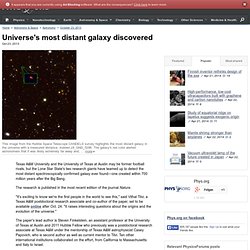
The research is published in the most recent edition of the journal Nature. "It's exciting to know we're the first people in the world to see this," said Vithal Tilvi, a Texas A&M postdoctoral research associate and co-author of the paper, set to be available online after Oct. 24. Galaxy HFLS3 is 12.8 billion light-years from Earth.
The galaxy, dubbed HFLS3 is 12.8 billion light-years from EarthFound to be 2,000 times more prolific than our own Milky Way By Mark Prigg Published: 15:18 GMT, 18 April 2013 | Updated: 16:09 GMT, 18 April 2013 Astronomers have found the most prolific star factory in the Universe.
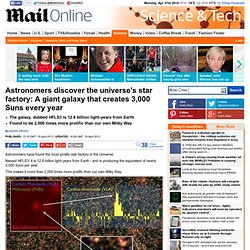
Named HFLS3, it is 12.8 billion light-years from Earth - and is producing the equivalent of nearly 3,000 Suns per year. This makes it more than 2,000 times more prolific than our own Milky Way. Needle in a Haystack: Named HFLS3, it is 12.8 billion light-years from Earth - and is producing the equivalent of nearly 3,000 Suns per year.
The first pictures from the £1bn 'time machine' telescope reveal faraway galaxy forming starburst. First images from groundbreaking ALMA telescope in Chile shows an ancient galaxy forming stars at a breathtaking rateRed arcs in the image represent a distant galaxy rapidly creating stars around 12billion years ago – the light generated has only just reached us on earth By Fiona Macrae Science Correspondent In Chile Published: 18:00 GMT, 13 March 2013 | Updated: 18:16 GMT, 13 March 2013 A long time ago, in a galaxy far, far away, billions of stars were born.
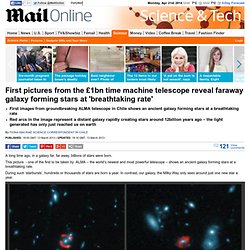
This picture - one of the first to be taken by ALMA – the world’s newest and most powerful telescope – shows an ancient galaxy forming stars at a breathtaking rate. During such ‘starbursts’, hundreds or thousands of stars are born a year. The first image from the ALMA telescope: This montage combines data from ALMA with images from the NASA/ESA Hubble Space Telescope, for five distant galaxies. When complete, ALMA will be even more sensitive, and will be able to detect even fainter galaxies.
'The baby pictures of the Universe': Hubble captures images of the earliest galaxies. One of the objects may be the oldest galaxy yet found, dating back to when the cosmos was just 380million years oldDiscoveries should help scientists figure out what was going on during the Universe's 'dark ages' before stars formed By Damien Gayle Published: 09:28 GMT, 13 December 2012 | Updated: 14:16 GMT, 14 December 2012 Astronomers peering through the Hubble Space Telescope have found galaxies so ancient they describe them as 'baby pictures of the Universe'.
The seven galaxies pictured formed relatively shortly after the dawn of time 13.7billion years ago and are the and are the most primitive and distant ever seen. The glittering galaxy so bright you can almost count the stars in it. By Mark Prigg Published: 11:53 GMT, 3 December 2012 | Updated: 11:59 GMT, 3 December 2012 While we are all used to seeing stunning pictures of far-off galaxies, researchers have discovered one of the brightest, clearest ever seen.

It is such an incredible find that researchers have dubbed it the 'glittering galaxy'. Despite being millions of light-years from Earth, the stars captured in this image are so bright and clear you could almost attempt to count them. Triple Merger Of Galaxies Looks Like A 'Cosmic Tinkerbell' Using ESO's Very Large Telescope, an international team of astronomers [1] has discovered a stunning rare case of a triple merger of galaxies.
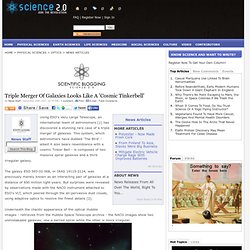
This system, which astronomers have dubbed 'The Bird' - albeit it also bears resemblance with a cosmic Tinker Bell - is composed of two massive spiral galaxies and a third irregular galaxy. The galaxy ESO 593-IG 008, or IRAS 19115-2124, was previously merely known as an interacting pair of galaxies at a distance of 650 million light-years. But surprises were revealed by observations made with the NACO instrument attached to ESO's VLT, which peered through the all-pervasive dust clouds, using adaptive optics to resolve the finest details [2]. Nasa captures a lonely galaxy from the 'dark ages' of the universe 13.2billion years ago - thanks to an extraordinary trick of the lens. By Eddie Wrenn Published: 14:25 GMT, 21 September 2012 | Updated: 14:25 GMT, 21 September 2012 The galaxy is so far away - the ray of light journeyed for 13.2 billion years to get bring us this image - that by rights, we should not be able to see it.

But thanks to a universe-wide trick of the light, we have been able to glimpse back at a galaxy so far, far away, and from such a long, long time ago, that its light shone out when the universe was just 500 million years old - and still shrouded in blackness. Nasa's Hubble satellite should not have been able to see it. But as the galaxy passed behind a giant cluster of galaxies, the cluster acted like a giant lens magnifying the light by 15 times - and bringing us this tiny glimpse of the universe in its earliest years. The image was released today - just as the finishing touches are put on to the mirrors of the James Webb Space Telescope, which will launch later this decade to bring back even more distant images.
The furthest object ever seen: Record breaking image shows galaxy 13.3 BILLION light-years from Earth. Galaxy was observed 420 million years after the Big Bangfound by NASA’s Hubble Space Telescope, Spitzer Space Telescope, and one of nature’s own natural 'zoom lenses' in space.

Stephan's Quintet: Five galaxies fighting for space rocked by shock wave bigger than Milky Way. Green arc between Stephan's Quintet is shock wave caused by falling galaxy By Daily Mail Reporter Updated: 07:08 GMT, 13 June 2012 Stephan's Quintet, a cluster of galaxies located about 280million light years from Earth, have been clashing and emitting bright lights for millennia.

Andromeda is out of control! Galaxy which will crash into the Milky Way in four billion years has already had one near-miss. Andromeda has already bumped past the 'Triangulum Galaxy'Stars will be tossed into different orbit around when galaxy hits Milky WayTwo billion years later, our two galaxies will 'merge' into one By Eddie Wrenn Published: 11:50 GMT, 12 June 2012 | Updated: 11:50 GMT, 12 June 2012 In four billion years, the Andromeda galaxy will come hurtling into the Milky Way - tearing planets and suns into new orbits in a fearsome and turbulent battle.

But Andromeda - flying towards us at more than 250,000 miles an hour - is already a bit of a galactic warrior, having already bumped up against the Triangulum Galaxy (otherwise known as M33). Recent studies with the National Science Foundation's Green Bank Telescope (GBT) seem to confirm a disputed 2004 discovery of hydrogen gas streaming between Andromeda and the Triangulum. Fast: Andromeda (pictured) is plowing toward Earth's galaxy at roughly 250,000 miles per hour, which is the equivalent of traveling from Earth to the moon in 60 minutes. NASA captures galaxies NGC 3314A and B 'smashing into each other' By Eddie Wrenn Published: 12:20 GMT, 13 June 2012 | Updated: 12:43 GMT, 13 June 2012 As intergalactic smashes go, this is a big one - two galaxies crashing into each other in a huge spinning frenzy.
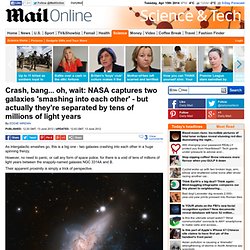
However, no need to panic, or call any form of space police, for there is a void of tens of millions of light years between the snappily-named galaxies NGC 3314A and B. Their apparent proximity is simply a trick of perspective. Newly-discovered 'Phoenix' galaxy produces 740 new stars a year. Unnamed galaxy produces more stars in a day than the Milky Way spawns in a yearThought to be about 6 billion years old, and has appeared to have 'come back to life'Scientist says the galaxy 'pushes the boundaries of what we understand' By Associated Press Published: 02:40 GMT, 16 August 2012 | Updated: 06:52 GMT, 16 August 2012 Scientists have found a cosmic supermom. They're everywhere! Nasa discovers millions of new 'supermassive black holes' - and thousands of new galaxies.
By Eddie Wrenn Published: 13:51 GMT, 30 August 2012 | Updated: 13:51 GMT, 30 August 2012 Nasa has discovered a 'bonanza' of supermassive black holes - as well as some extreme galaxies called 'Hot DOGs', otherwise known as dust-obscured galaxies. Nasa's Wide-field Infrared Survey Explorer (WISE) revealed millions of dusty black hole candidates across the universe and about 1,000 even dustier objects thought to be among the brightest galaxies ever found. These are powerful galaxies that burn brightly with infrared light. Hashima Hasan, WISE program scientist at Nasa Headquarters in Washington, said: 'WISE has exposed a menagerie of hidden objects. 'We've found an asteroid dancing ahead of Earth in its orbit, the coldest star-like orbs known and now, supermassive black holes and galaxies hiding behind cloaks of dust.' WISE scanned the whole sky twice in infrared light, completing its survey in early 2011.
So far, they have identified about 1,000 candidates. Dim and distant past: Scientists sight 'dark dwarf' galaxy a record-breaking 10 billion light years away. Astronomers Uncover A Surprising Trend in Galaxy Evolution (2) Astronomers Uncover A Surprising Trend in Galaxy Evolution A comprehensive study of hundreds of galaxies observed by the Keck telescopes in Hawaii and NASA's Hubble Space Telescope has revealed an unexpected pattern of change that extends back 8 billion years, or more than half the age of the universe. "Astronomers thought disk galaxies in the nearby universe had settled into their present form by about 8 billion years ago, with little additional development since," said Susan Kassin, an astronomer at NASA's Goddard Space Flight Center in Greenbelt, Md., and the study's lead researcher.
"The trend we've observed instead shows the opposite, that galaxies were steadily changing over this time period. " Today, star-forming galaxies take the form of orderly disk-shaped systems, such as the Andromeda Galaxy or the Milky Way, where rotation dominates over other internal motions. Astronomers Uncover a Surprising Trend In Galaxy Evolution (1)
RELEASE : 12-364 Astronomers Uncover a Surprising Trend In Galaxy Evolution WASHINGTON -- A comprehensive study of hundreds of galaxies observed by the Keck telescopes in Hawaii and NASA's Hubble Space Telescope has revealed an unexpected pattern of change that extends back 8 billion years, or more than half the age of the universe. "Astronomers thought disk galaxies in the nearby universe had settled into their present form by about 8 billion years ago, with little additional development since," said Susan Kassin, an astronomer at NASA's Goddard Space Flight Center in Greenbelt, Md., and the study's lead researcher. "The trend we've observed instead shows the opposite, that galaxies were steadily changing over this time period. " Today, star-forming galaxies take the form of orderly disk-shaped systems, such as the Andromeda Galaxy or the Milky Way, where rotation dominates over other internal motions.
For images and video related to this story, please visit: This spilled salt (actually, it's a cluster of stars) helps solve the mystery of the missing dwarf galaxies.